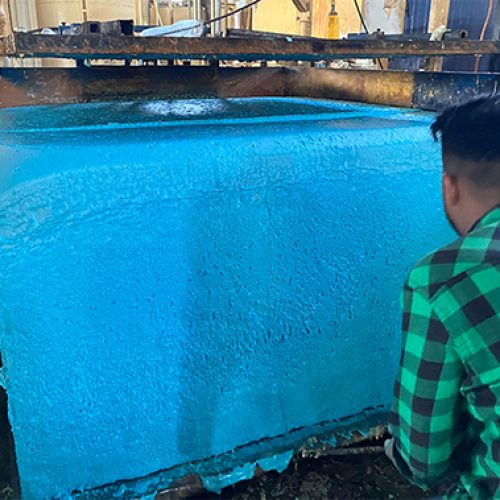1.Large Pores: The foam is composed of large pores.
Recommendations: Check the dosage and activity of silicon copper; for low-pressure foaming machines, increase mixing speed/air injection quantity, and for high-pressure foaming machines, reduce mixing head pressure.
2.Dead Cells: The foam has low elasticity and sealed pores.
Recommendations: Reduce tin catalyst; reduce silicone usage; attempt to produce foam with smaller pores.
3.Slow Curing: Polymer strength increases too slowly, resulting in foam that is too soft, sticky, and difficult to cut, with unstable shapes when extruded from the machine.
Recommendations: Increase the dosage of amine and/or tin catalysts; check for any errors in water/TDI/polyol/tin measurements.
4.Poor Compression Recovery: The foam has a slow recovery rate when subjected to sharp object pressure.
Recommendations: Reduce tin catalyst and/or silicone usage to improve air flow in the foam; attempt to produce foam with smaller pores; enhance curing conditions.
5.Brittleness: The foam is brittle and doesn’t reach the desired polymer strength.
Recommendations: Check for errors in tin/polyol/TDI/water measurements; check for reduced activity in tin catalysts.
6.Odor: The produced foam emits an odor.
Recommendations: Try using alternative amine catalysts; allow the foam to vent for a period.
7.Surface Tackiness: The material surface remains tacky over extended periods.
Recommendations: Increase the overall catalyst dosage.
8.Narrow Range of Tin Catalyst: The formula indicates a narrow operating range for tin catalysts, resulting in little difference between cracking and cell opening.
Recommendations: If activation time allows, reduce amine catalyst usage; use auxiliary catalysts; decrease silicone content; opt for lower activity silicones.
9.Active Cracking: The material block produces smooth, large cracks.
Recommendations: Lower the total activity of the foam system, i.e., reduce amine, tin catalyst, and silicone; check TDI output.
10.Sagging: The material block collapses after reaching its maximum height.
Recommendations: Increase silicone usage; check output; increase tin catalyst dosage; check output.
11.Shrinkage: The material block shrinks during curing.
Recommendations: Reduce tin catalyst; reduce silicone usage; for low-pressure foaming machines, increase mixing speed/check air injection quantity; for high-pressure foaming machines, reduce mixing head pressure; check for system contamination.
12.Holes: Small holes are irregularly distributed throughout the foam.
Recommendations: Increase tin catalyst concentration; enlarge cell size.
13.Bottom Hollows: The material block contains sealed pores that consume the bottom portion.
Recommendations: Reduce tin catalyst; check for measurement errors.
14.Low Tensile Strength: Tensile strength is lower than expected.
Recommendations: Check TDI/water/polyol output; reduce foam cell size (see “Large Pores” above).
15.Low Elongation: Elongation is lower than expected.
Recommendations: Check TDI/water/polyol output; reduce TDI index.
16.Excessive Compression Set: Compression permanent deformation exceeds 10%.
Recommendations: Reduce tin and silicone usage; use TDI with an index of 105-108; employ auxiliary curing methods; improve curing conditions.
17.Low Load-Bearing Capacity: The formula’s obtained load-bearing capacity is lower than expected.
Recommendations: Increase the TDI index; check for output measurement errors.
18.Excessive Load-Bearing Capacity: The formula’s obtained load-bearing capacity is higher than expected.
Recommendations: Check for correct water/TDI/polyol output; lower the TDI index.

